Probabilistic Collapse Design and Safety Assessment of Sandwich Pipelines
Abstract
:1. Introduction
2. Methodology
2.1. Collapse Strength Models for SP
2.2. Classification of Models
2.3. Error Assessment
2.4. Deterministic Evaluation of Uncertainty
2.5. Probabilistic Assessment
3. Results and Discussion
3.1. Experimental Validation of Strength Models
3.2. Deterministic Assessment of SP Collapse Strength Models
3.2.1. Effect of Outer Pipe Thickness
3.2.2. Effect of Core Thickness
3.2.3. Effect of Inner Pipe Thickness
3.2.4. Effect of Core Material Elasticity
3.3. Probabilistic Analysis
3.3.1. Uncertainty Propagation
3.3.2. Estimation of Reliability Indices
3.3.3. Sensitivity Analysis
3.3.4. Design Case for Target Reliability
3.3.5. Partial Safety Factors
3.4. Parametric Analysis
3.4.1. Reliability Variation with Outer Pipe Thickness
3.4.2. Reliability Variation with Core Thickness
3.4.3. Reliability Variation with External Pressure
4. Conclusions
Author Contributions
Funding
Institutional Review Board Statement
Informed Consent Statement
Data Availability Statement
Conflicts of Interest
Nomenclature and Symbols
| Symbols | Description |
| Sensitivity measure or factor | |
| Collapse pressure | |
| Calibrated model prediction | |
| Collapse pressure of outer pipe | |
| Elastic pressure | |
| Experimental collapse pressure | |
| Plastic pressure | |
| Joint probability density function | |
| Ovality of pipe | |
| Limit state surface curvatures | |
| Yield strength of outer (1) and inner pipe (2) | |
| a, b, c, d, e, f, g, h, i, j, k, l, m | Coefficients in T3 model |
| COV | Coefficient of variation |
| D1,2 | Outer diameter of outer (1) and inner pipe (2) |
| Ep,c | Young’s modulus of pipe (p) and core (c) |
| EQ() | EUREQA model |
| FB | Fully bonded core |
| FORM | First Order Reliability Method |
| h1–16 | Coefficients in HT model |
| HT() | Models by He et al. |
| k | Design safety factor |
| L | Load |
| LN | Log Normal distribution |
| LRFD | Load and resistance partial safety factor design |
| MCS | Monte Carlo Simulation |
| N | Normal distribution |
| N | Number of experiments |
| n | Buckling mode number |
| PB | Partially bonded core |
| Peq | Collapse capability for single walled equivalent pipe |
| Pf | Probability of failure |
| PiP | Pipe in Pipe |
| Pmin | Minimum internal pressure |
| R | Resistance |
| r1,2, c | Maximum radius of outer (1), inner pipe (2) and core (c) |
| s | Standard deviation |
| SORM | Second Order Reliability Method |
| SP | Sandwich pipelines |
| SP() | Models by Sato and Patel |
| t1,2, c | Maximum thickness for outer (1), inner pipe (2) and core (c) layers of SP |
| T1,2,3() | Models by Arjomandi and Taheri |
| u* | Design point |
| UB | Unbonded core |
| vp,c | Poisson ratio of pipe (p) and core (c) |
| Xc | Model uncertainty factor |
| Yg() | Models by Yang et al. |
| γL, γR | Partial safety factors for load (L) and resistance (R) |
| γm and γSC | Factors accounting for material resistance (m) and safety class (SC) |
| θ0–15 | Coefficients in Yang et al. model |
| κ, α1–2, γ1–3, ξ1–4 | Coefficients in T2 model |
| μ | Absolute mean error |
| Limit state function | |
| Reliability index | |
| PE | Prediction Error |
Appendix A
| Model Description | Symbol Ref. | ||||||||||
|---|---|---|---|---|---|---|---|---|---|---|---|
| 1. | Fully bonded | ||||||||||
| SP(FB) [17] | |||||||||||
| T1(FB) [25] | |||||||||||
| T2(FB) [26] | |||||||||||
| κ | α1 | α2 | γ1 | γ2 | γ3 | ξ1 | ξ2 | ξ3 | ξ4 | ||
| 0.9844 | −0.5444 | 0.1 | 0.474 | 0.98 | 1.062 | 0.43 | 0.079 | −0.1031 | 2.8 | ||
| T3(FB) [27] | |||||||||||
| a | b | c | d | e | f | g | |||||
| (Ec = 0.1) | 2.032 | 0.909 | 0.377 | 1.055 | 0.759 | 0.152 | 0.884 | ||||
| (Ec = 0.01) | 0.765 | 1.068 | 0.253 | 0.89 | 0.422 | 0.148 | 0.947 | ||||
| (Ec = 0.001) | 1.406 | 2.102 | −0.134 | 0.747 | 0.231 | −0.016 | 2.742 | ||||
| h | i | j | k | l | m | ||||||
| (Ec = 0.1) | −0.224 | 1.021 | 7.25 × 10−2 | −0.067 | −0.094 | 3.833 | |||||
| (Ec = 0.01) | 0.112 | 0.777 | 6.02 × 10−2 | −0.943 | −0.689 | 3.871 | |||||
| (Ec = 0.001) | −0.515 | 0.317 | 2.46 × 10−2 | −0.244 | 0.206 | 1.133 | |||||
| 2. | Partially bonded core | ||||||||||
| a | Outer bonded | ||||||||||
| Pc same as T2(FB), coefficient given below | T2(OB) [26] | ||||||||||
| κ | α1 | α2 | γ1 | γ2 | γ3 | ξ1 | ξ2 | ξ3 | ξ4 | ||
| 1.019 | 0.2461 | −0.0904 | 0.816 | 0.982 | 3.146 | 0.1792 | 0.0329 | −0.1062 | 2.929 | ||
| Pc same as T3(FB), coefficient given below | T3(OB) [27] | ||||||||||
| b | c | d | e | f | g | ||||||
| (Ec = 0.1) | 0.773 | 1.757 | −1.018 | 1.148 | 0.182 | −0.032 | 0.648 | ||||
| (Ec = 0.01) | 5.21 | 2.552 | −0.083 | 0.795 | 3.029 | 0.026 | 2.391 | ||||
| (Ec = 0.001) | 3.071 | 2.617 | −0.111 | 0.662 | 0.102 | −0.234 | 2.695 | ||||
| h | i | j | k | l | m | ||||||
| (Ec = 0.1) | 0.964 | 0.586 | 3.40 × 10−2 | −0.341 | −0.198 | 4.444 | |||||
| (Ec = 0.01) | −0.039 | 0.741 | 2.42 × 10−3 | −0.153 | −0.033 | 2.622 | |||||
| (Ec = 0.001) | −0.093 | 0.176 | 1.59 × 10−3 | −0.043 | 0.033 | 3.272 | |||||
| b | Inner bonded | ||||||||||
| Pc same as T2(FB), coefficient given below | T2(IB) [26] | ||||||||||
| κ | α1 | α2 | γ1 | γ2 | γ3 | ξ1 | ξ2 | ξ3 | ξ4 | ||
| 0.9814 | 1.3922 | 0.083 | 0.712 | 0.962 | 2.827 | 0.202 | 0.041 | −0.188 | 2.913 | ||
| Pc same as T3(FB), coefficient given below | T3(IB) [27] | ||||||||||
| a | b | c | d | e | f | g | |||||
| (Ec = 0.1) | 1.26 | 0.63 | 1.54 | 0.81 | 0.01 | 0.52 | 0.48 | ||||
| (Ec = 0.01) | 1.45 | 2.14 | 0.14 | 0.66 | 4.85 | −0.01 | 2.71 | ||||
| (Ec = 0.001) | 1.29 | 2.33 | 0.03 | 0.6 | 0.01 | −0.47 | 0.69 | ||||
| h | i | j | k | l | m | ||||||
| (Ec = 0.1) | −1.25 | 0.75 | 4.02 × 10−2 | −0.06 | −0.29 | 3.95 | |||||
| (Ec = 0.01) | −0.17 | 0.77 | 1.74 × 10−3 | −0.12 | −0.21 | 2.8 | |||||
| (Ec= 0.001) | 2.27 | 0.45 | 3.66 × 10−2 | −0.25 | 3.11 | −0.46 | |||||
| c | Inter−layer adhesion | ||||||||||
| HT (1.5) [28] | |||||||||||
| h1 | h2 | h3 | h4 | h5 | h6 | h7 | h8 | ||||
| 28.538 | 4.249 | 1.191 | −0.028 | 0.341 | 0.744 | −0.002 | 0.085 | ||||
| h9 | h10 | h11 | h12 | h13 | h14 | h15 | h16 | ||||
| 2.472 | 0.585 | −0.176 | 9.54 × 10−6 | 0.286 | −3.071 | −0.094 | −0.359 | ||||
| Pc same as above, coefficient given below | HT (15) [28] | ||||||||||
| h1 | h2 | h3 | h4 | h5 | h6 | h7 | h8 | ||||
| 31.791 | 3.04 | 0.701 | −0.126 | 0.915 | 0.059 | 0.163 | −0.221 | ||||
| h9 | h10 | h11 | h12 | h13 | h14 | h15 | h16 | ||||
| 1.138 | 0.53 | −0.136 | 7.29 × 10−6 | 0.038 | −3.993 | −0.319 | −0.077 | ||||
| 3. | Core unbounded | ||||||||||
| SP(UB) [17] | |||||||||||
| Pc same as T2(FB), coefficient given below | T2(UB) [26] | ||||||||||
| κ | α1 | α2 | γ1 | γ2 | γ3 | ξ1 | ξ2 | ξ3 | ξ4 | ||
| 0.9833 | 1.106 | −0.0945 | 0.336 | 0.966 | 3.631 | 0.1589 | 0.0184 | −0.0837 | 3.01 | ||
| Pc same as T3(FB), coefficient given below | T3(UB) [27] | ||||||||||
| a | b | c | d | e | f | g | |||||
| (Ec = 0.1) | 3.42 | 3.26 | −0.5 | 0.59 | 0.06 | −0.15 | −0.12 | ||||
| (Ec = 0.01) | 0.77 | 2.63 | −0.21 | 0.47 | 0.02 | −0.04 | −0.12 | ||||
| (Ec = 0.001) | 2.14 | 2.7 | −0.04 | 0.54 | 0.19 | −0.06 | 0.27 | ||||
| h | i | j | k | l | m | ||||||
| (Ec = 0.1) | 3.12 | 0.3 | 0.00697 | 0.07 | 2.87 | −1.53 | |||||
| (Ec = 0.01) | 3.21 | 0.4 | 0.0766 | −0.03 | 2.91 | −0.27 | |||||
| (Ec = 0.001) | 4.48 | 0.6 | 0.0675 | −0.2 | 3.03 | −0.21 | |||||
| Yg(UB) [4] | |||||||||||
| θ0 | θ1 | θ2 | θ3 | θ4 | θ5 | θ6 | θ7 | ||||
| −5.8433 | 7.65762 | −0.0226 | −0.0877 | 0.42328 | 3.240446 | −0.6458 | 0.56457 | ||||
| θ8 | θ9 | θ10 | θ11 | θ12 | θ13 | θ14 | θ15 | ||||
| 14.115 | 0.72154 | 0.8829 | 0.36618 | 23.4687 | 4.2532 | −0.7719 | 0.29961 | ||||
| EQ(UB) [4] | |||||||||||
Appendix B
| SP | D1 | t1 | tc | D2 | t2 | Pexp (MPa) |
|---|---|---|---|---|---|---|
| Steel pipe, Cementitious core | 203.2 | 2 | 23.4 | 152.4 | 2 | 37.68 |
| 203.2 | 2 | 23.4 | 152.4 | 2 | 35.96 | |
| 203.2 | 2 | 23.4 | 152.4 | 2 | 35.23 | |
| 203.2 | 2 | 23.4 | 152.4 | 2 | 37.18 | |
| 203.2 | 2 | 23.4 | 152.4 | 2 | 36.92 | |
| 219.08 | 2.77 | 22.63 | 168.28 | 2.77 | 38.71 | |
| 219.08 | 2.77 | 22.63 | 168.28 | 2.77 | 34.29 | |
| 219.08 | 2.77 | 22.63 | 168.28 | 2.77 | 37.57 | |
| 219.08 | 2.77 | 22.63 | 168.28 | 2.77 | 39.05 | |
| Aluminium pipe, Polypropylene core | 74.97 | 1.62 | 11.29 | 49.15 | 1.62 | 43.35 |
| 75.92 | 1.65 | 11.13 | 50.36 | 1.63 | 34.09 | |
| 62.16 | 1.47 | 4.23 | 50.76 | 1.68 | 10.98 | |
| 62.25 | 1.47 | 4.3 | 50.71 | 1.67 | 12.11 | |
| 75.4 | 1.62 | 11.26 | 49.64 | 1.68 | 37.64 | |
| 75.18 | 1.61 | 11.1 | 49.76 | 1.62 | 31.14 | |
| 62.1 | 1.46 | 4.62 | 49.94 | 1.7 | 20.31 | |
| 62.39 | 1.49 | 4.69 | 50.03 | 1.69 | 17.13 | |
| Aluminium pipe, Polypropylene core | 69.44 | 3.34 | 5.5 | 50.96 | 3.19 | 4.9 |
| 70 | 3 | 5.33 | 50.96 | 3.08 | 11.52 | |
| 70 | 3 | 5.33 | 50.96 | 4.08 | 13.1 | |
| 70 | 3 | 5.33 | 50.96 | 5.08 | 11.06 | |
| Steel pipe, Cementitious core | 202.8 | 2 | 23.2 | 152.4 | 1.8 | 30.5 |
| 203 | 2 | 23.2 | 152.6 | 1.8 | 30.6 | |
| 203 | 2 | 23.2 | 152.6 | 1.8 | 29.7 |
References
- Bhardwaj, U.; Teixeira, A.P.; Guedes Soares, C. Reliability Assessment of a Subsea Pipe-in-Pipe System for Major Failure Modes. Int. J. Press. Vessel. Pip. 2020, 188, 104177. [Google Scholar] [CrossRef]
- Standard-ST-F101; Submarine Pipeline Systems. DNV: Byrum, Norway, 2021; Det Norske Veritas Elendom AS.
- Netto, T.A.; Santos, J.M.C.; Estefen, S.F. Sandwich Pipes for Ultra-Deep Waters. In Proceedings of the 2002 4th International Pipeline Conference, Calgary, AB, Canada, 29 September–3 October 2002; pp. 2093–2101. [Google Scholar] [CrossRef]
- Yang, J.; Estefen, S.F.; Fu, G.; Paz, C.M.; Lourenço, M.I. Collapse Pressure of Sandwich Pipes with Strain-Hardening Cementitious Composite-Part 2: A Suitable Prediction Equation. Thin-Walled Struct. 2020, 148, 106606. [Google Scholar] [CrossRef]
- Yang, J.; Paz, C.M.; Estefen, S.F.; Fu, G.; Lourenço, M.I. Collapse Pressure of Sandwich Pipes with Strain-Hardening Cementitious Composite-Part 1: Experiments and Parametric Study. Thin-Walled Struct. 2020, 148, 106605. [Google Scholar] [CrossRef]
- An, C.; Duan, M.; Toledo Filho, R.D.; Estefen, S.F. Collapse of Sandwich Pipes with PVA Fiber Reinforced Cementitious Composites Core under External Pressure. Ocean Eng. 2014, 82, 1–13. [Google Scholar] [CrossRef]
- Castello, X.; Estefen, S.F.; Leon, H.R.; Fritz, M. Collapse of Sandwich Pipes with Different Annular Materials. In Proceedings of the IBP-Rio Pipeline Conference & Exposition, Rio de Janeiro, Brazil, 2–4 October 2007. [Google Scholar] [CrossRef]
- Alrsai, M.; Karampour, H.; Albermani, F. Numerical Study and Parametric Analysis of the Propagation Buckling Behaviour of Subsea Pipe-in-Pipe Systems. Thin-Walled Struct. 2018, 125, 119–128. [Google Scholar] [CrossRef] [Green Version]
- Estefen, S.F.; Netto, T.A.; Pasqualino, I.P. Strength Analyses of Sandwich Pipes for Ultra Deepwaters. ASME J. Appl. Mech. 2005, 72, 599–608. [Google Scholar] [CrossRef]
- Xu, Q.; Gong, S.; Hu, Q. Collapse Analyses of Sandwich Pipes under External Pressure Considering Inter-Layer Adhesion Behaviour. Mar. Struct. 2016, 50, 72–94. [Google Scholar] [CrossRef]
- Castello, X.; Estefen, S.F. Adhesion Effect on the Ultimate Strength of Sandwich Pipes. In Proceedings of the 25th International Conference on Offshore Mechanics and Arctic Engineering, Hamburg, Germany, 4–9 June 2006. ASME Paper No. OMAE2006-92481. [Google Scholar]
- Teixeira, A.P.; Zayed, A.; Guedes Soares, C. Reliability of Pipelines with Non-Uniform Corrosion. J. Ocean Sh. Technol. 2010, 1, 12–30. [Google Scholar]
- Teixeira, A.P.; Guedes Soares, C.; Netto, T.A.; Estefen, S.F. Reliability of Pipelines with Corrosion Defects. Int. J. Press. Vessel. Pip. 2008, 85, 228–237. [Google Scholar] [CrossRef]
- Bhardwaj, U.; Teixeira, A.P.; Guedes Soares, C.; Azad, M.S.; Punurai, W.; Asavadorndeja, P. Reliability Assessment of Thick High Strength Pipelines with Corrosion Defects. Int. J. Press. Vessel. Pip. 2019, 177, 103982. [Google Scholar] [CrossRef]
- Teixeira, A.P.; Palencia, O.G.; Guedes Soares, C. Reliability Analysis of Pipelines with Local Corrosion Defects under External Pressure. ASME J. Offshore Mech. Arct. Eng. 2018, 141, 051601. [Google Scholar] [CrossRef]
- Arjomandi, K.; Taheri, F. Elastic Buckling Capacity of Bonded and Unbonded Sandwich Pipes under External Hydrostatic Pressure. J. Mech. Mater. Struct. 2010, 5, 391–408. [Google Scholar] [CrossRef]
- Sato, M.; Patel, M.H. Exact and Simplified Estimations for Elastic Buckling Pressures of Structural Pipe-in-Pipe Cross Sections under External Hydrostatic Pressure. J. Mar. Sci. Technol. 2007, 12, 251–262. [Google Scholar] [CrossRef]
- Hashemian, R.; Mohareb, M. Buckling Finite Element Formulation for Sandwich Pipes under External Pressure. Int. J. Press. Vessel. Pip. 2016, 147, 41–54. [Google Scholar] [CrossRef]
- Hashemian, R.; Mohareb, M. Finite Difference Model for the Buckling Analysis of Sandwich Pipes under External Pressure. Ocean Eng. 2016, 122, 172–185. [Google Scholar] [CrossRef]
- Bhardwaj, U.; Teixeira, A.; Guedes Soares, C. Uncertainty in Collapse Strength Prediction of Sandwich Pipelines. J. Offshore Mech. Arct. Eng. 2022, 144, 041702. [Google Scholar] [CrossRef]
- Pasqualino, I.P.; Pinheiro, B.C.; Estefen, S.F. Comparative Structural Analyses between Sandwich and Steel Pipelines for Ultra-Deep Water. In Proceedings of the ASME 2002 21st International Conference on Offshore Mechanics and Arctic Engineering, Oslo, Norway, 23–28 June 2002. ASME Paper No. OMAE2002-28455. [Google Scholar]
- Castello, X.; Estefen, S.F.; Leon, H.R.; Chad, L.C.; Souza, J. Design Aspects and Benefits of Sandwich Pipes for Ultra Deepwaters. In Proceedings of the ASME 2009 28th International Conference on Ocean, Offshore and Arctic Engineering, Honolulu, HI, USA, 31 May–5 June 2009; Volume 3, pp. 453–459. [Google Scholar] [CrossRef]
- Castello, X.; Estefen, S.F. Limit Strength and Reeling Effects of Sandwich Pipes with Bonded Layers. Int. J. Mech. Sci. 2007, 49, 577–588. [Google Scholar] [CrossRef]
- Castello, X.; Estefen, S.F. Sandwich Pipes for Ultra Deepwater Applications. In Proceedings of the Offshore Technology Conference, Houston, TX, USA, 5–8 May 2008. [Google Scholar] [CrossRef]
- Arjomandi, K.; Taheri, F. A New Look at the External Pressure Capacity of Sandwich Pipes. Mar. Struct. 2011, 24, 23–42. [Google Scholar] [CrossRef]
- Arjomandi, K.; Taheri, F. Stability and Post-Buckling Response of Sandwich Pipes under Hydrostatic External Pressure. Int. J. Press. Vessel. Pip. 2011, 88, 138–148. [Google Scholar] [CrossRef]
- Arjomandi, K.; Taheri, F. The Influence of Intra-Layer Adhesion Configuration on the Pressure Capacity and Optimized Configuration of Sandwich Pipes. Ocean Eng. 2011, 38, 1869–1882. [Google Scholar] [CrossRef]
- He, T.; Duan, M.; Wang, J.; Lv, S.; An, C. On the External Pressure Capacity of Deepwater Sandwich Pipes with Inter-Layer Adhesion Conditions. Appl. Ocean Res. 2015, 52, 115–124. [Google Scholar] [CrossRef]
- SMLH Eureqa Version 0.98 Beta. Available online: https://www.nutonian.com (accessed on 25 May 2022).
- Melchers, R.E.; Beck, A.T. Structural Reliability—Analysis and Prediction; Melchers, R.E., Beck, A.T., Eds.; John Wiley & Sons Ltd.: Chichester, UK, 2018; ISBN 9781119266105. [Google Scholar]
- Ditlevsen, O.; Madsen, H.O. Structural Reliability Methods; John Wiley & Sons Ltd.: Chichester, UK, 2005. [Google Scholar]
- Ang, A.H.S.; Tang, W.H. Probability Concepts in Engineering: Emphasis on Applications to Civil and Environmental Engineering; John Wiley & Sons Inc.: Hoboken, NJ, USA, 2006. [Google Scholar]
- Gong, S.; Wang, X.; Zhang, T.; Liu, C. Buckle Propagation of Sandwich Pipes under External Pressure. Eng. Struct. 2018, 175, 339–354. [Google Scholar] [CrossRef]
- Blake, J.I.R.; Shenoi, R.A.; Das, P.K.; Yang, N. The Application of Reliability Methods in the Design of Stiffened FRP Composite Panels for Marine Vessels. Ships Offshore Struct. 2009, 4, 287–297. [Google Scholar] [CrossRef]
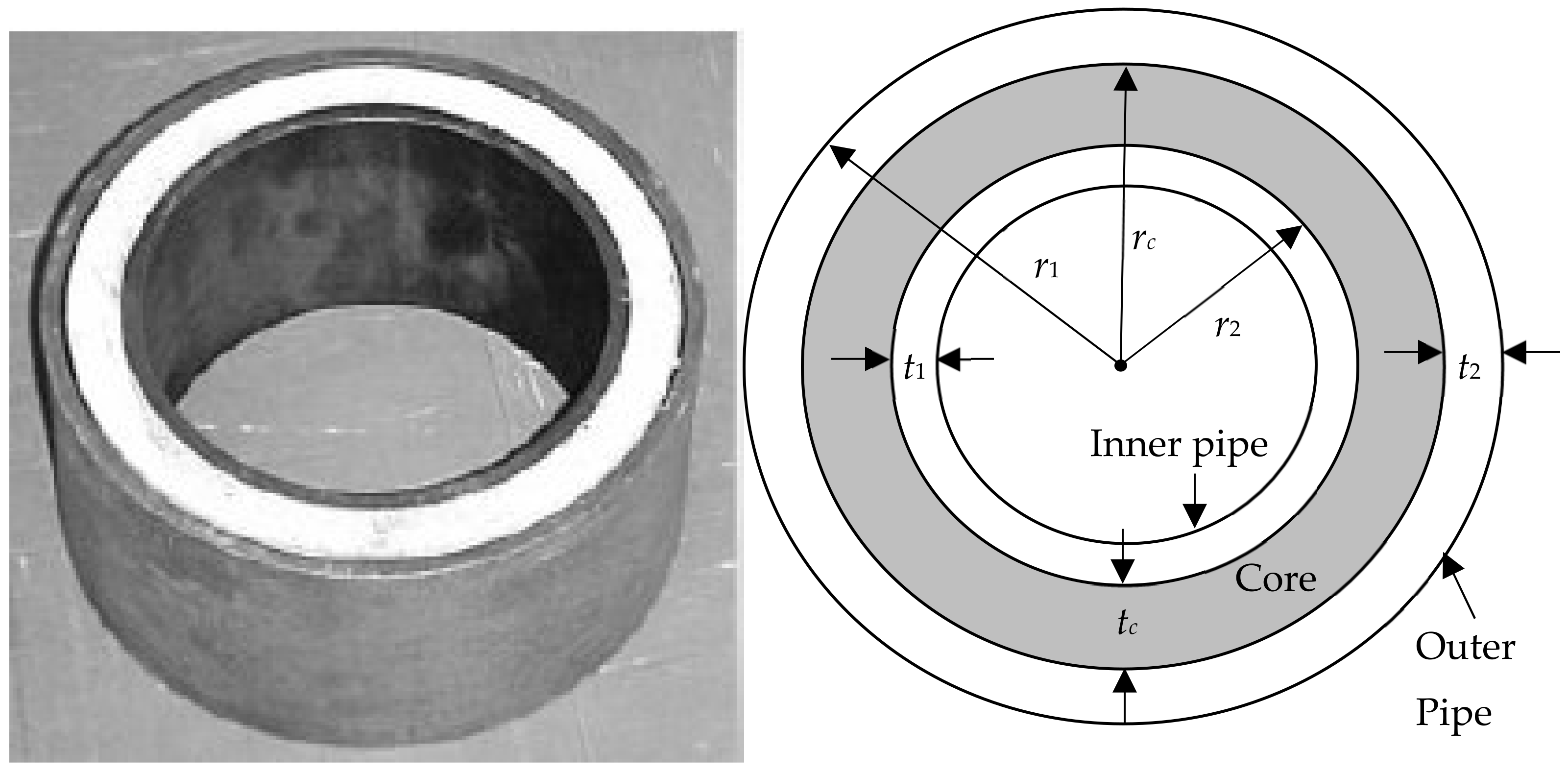
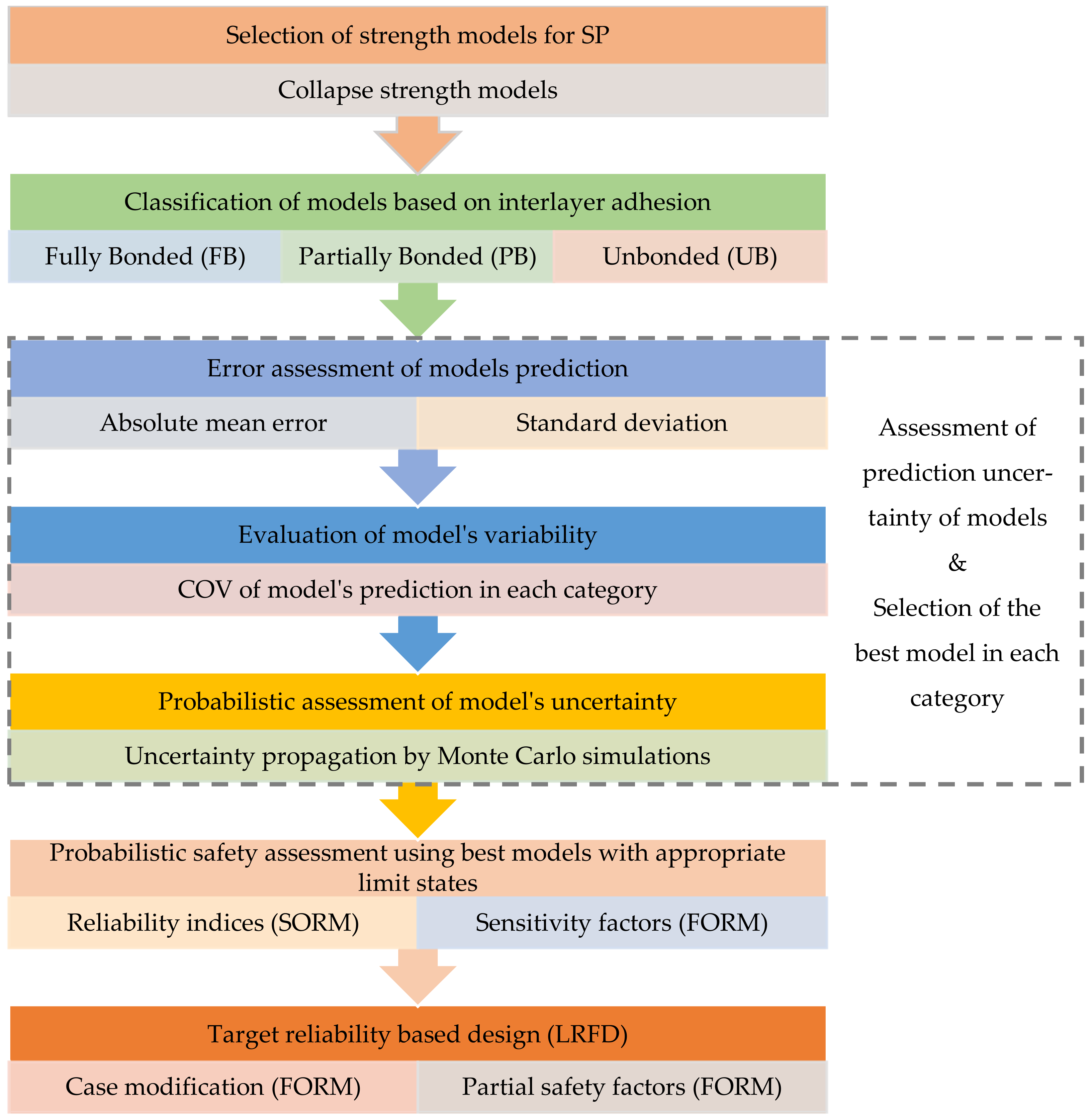
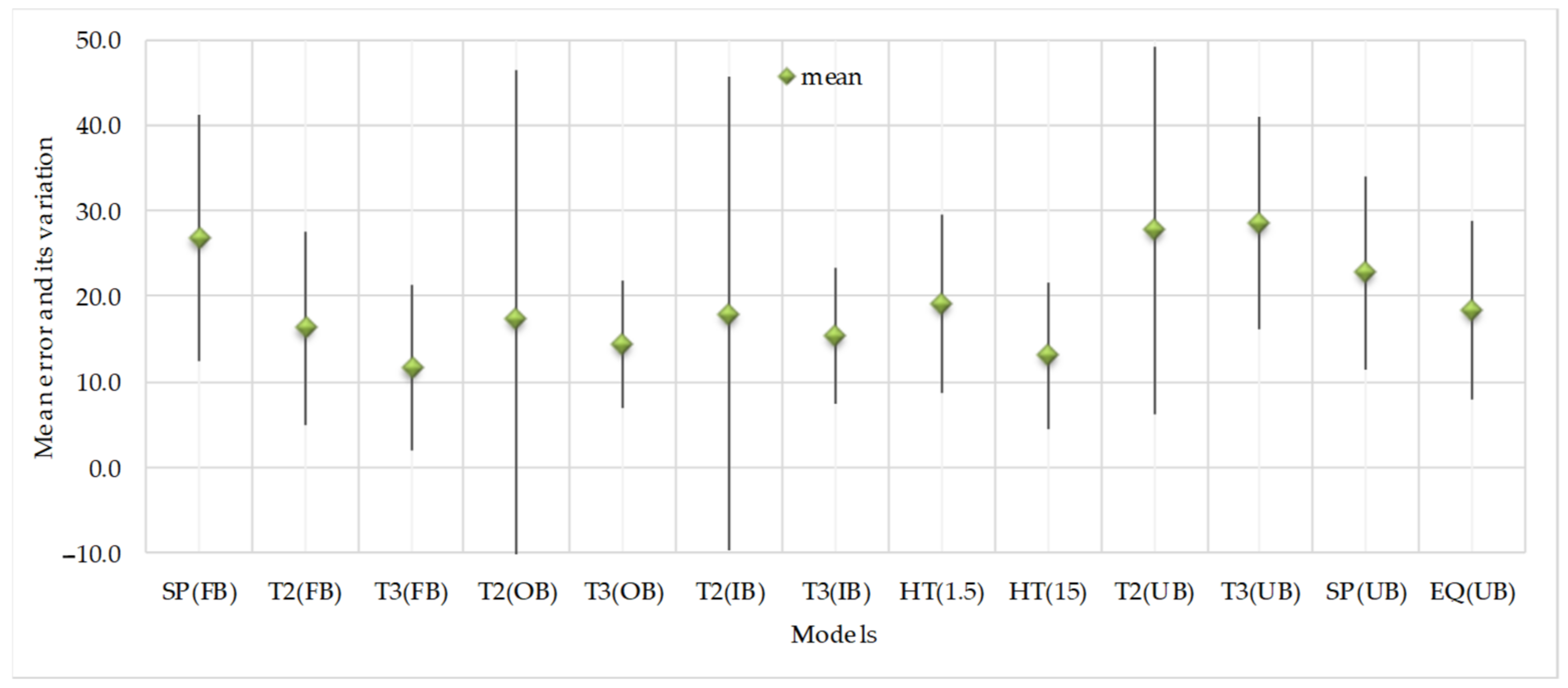

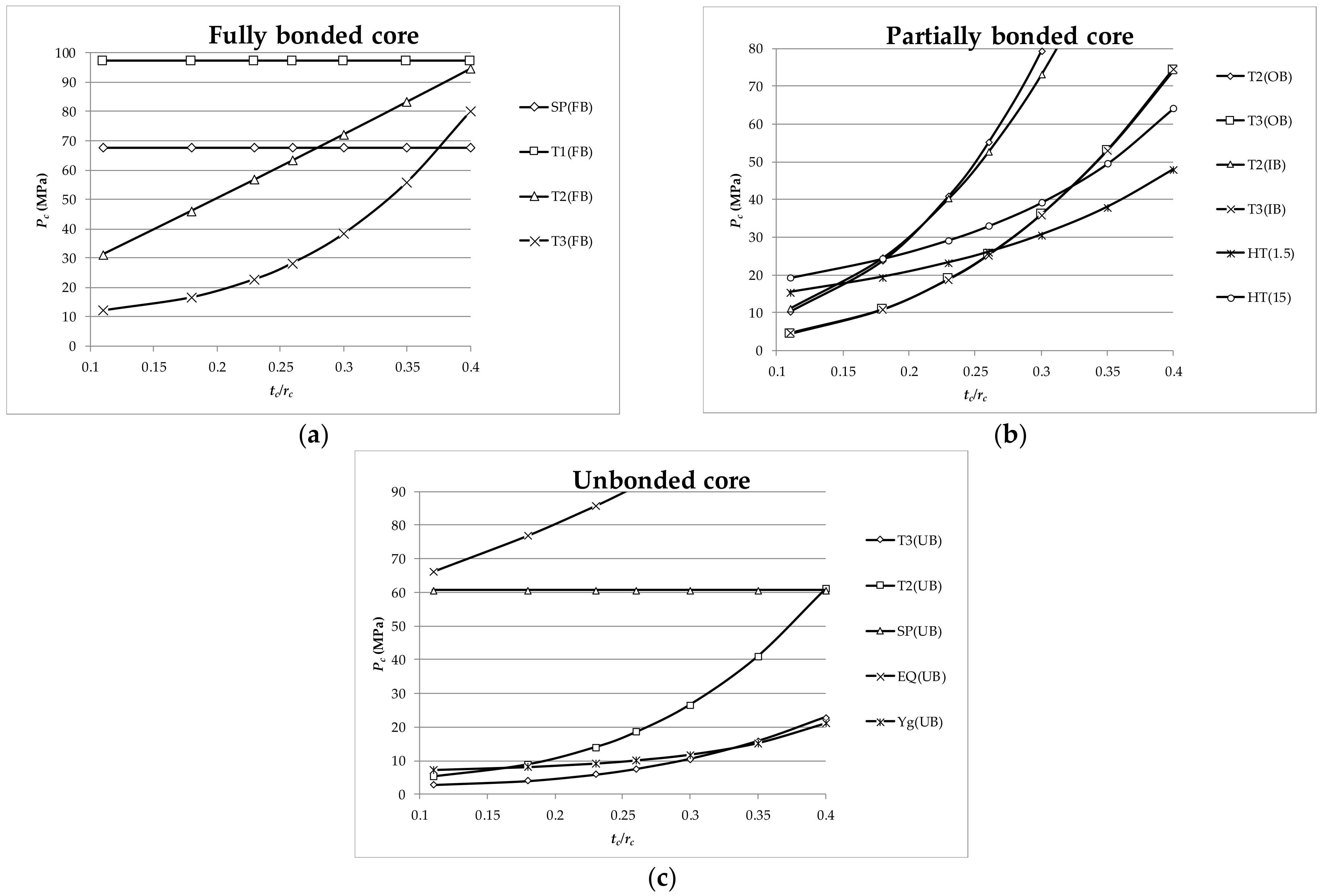
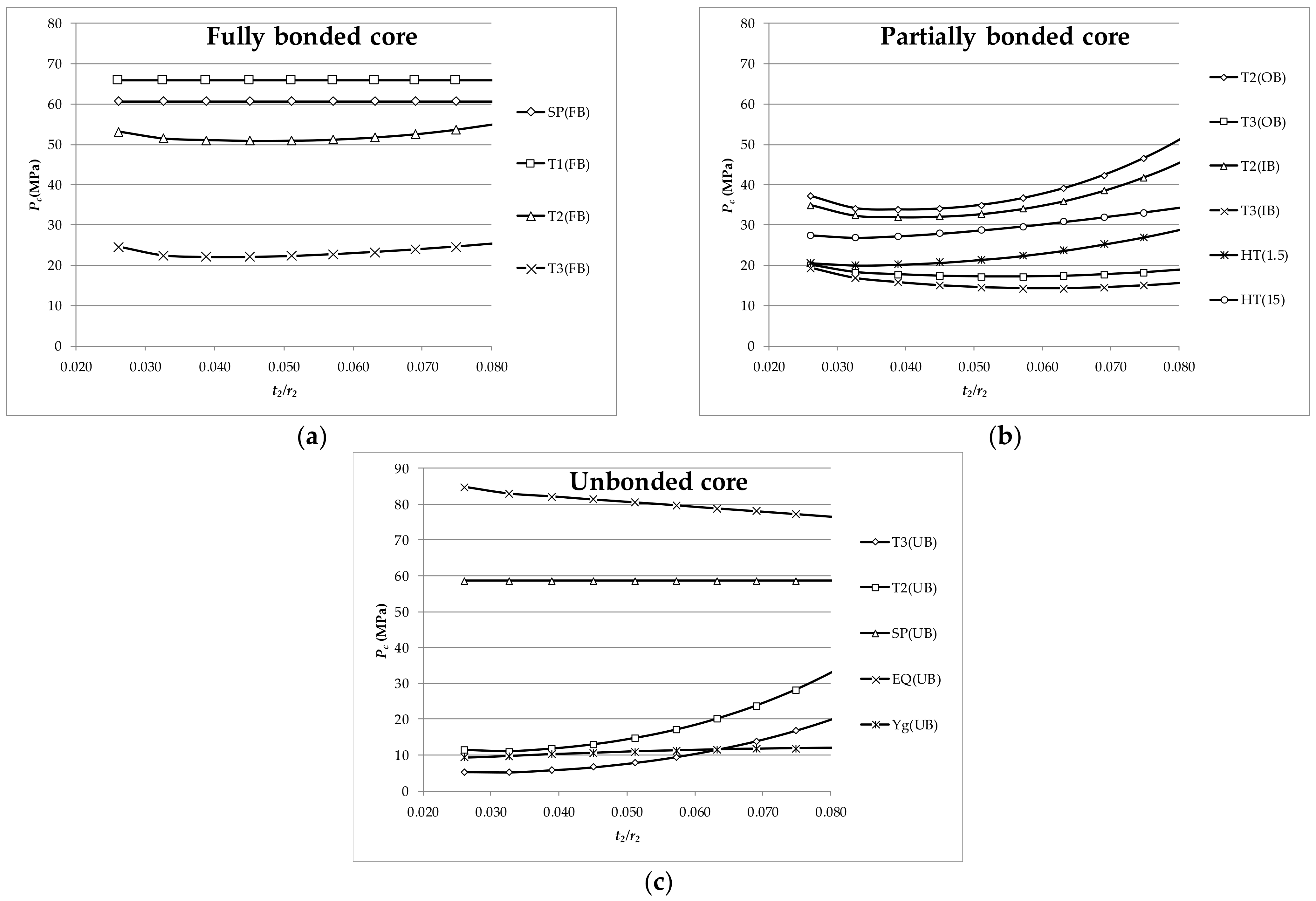
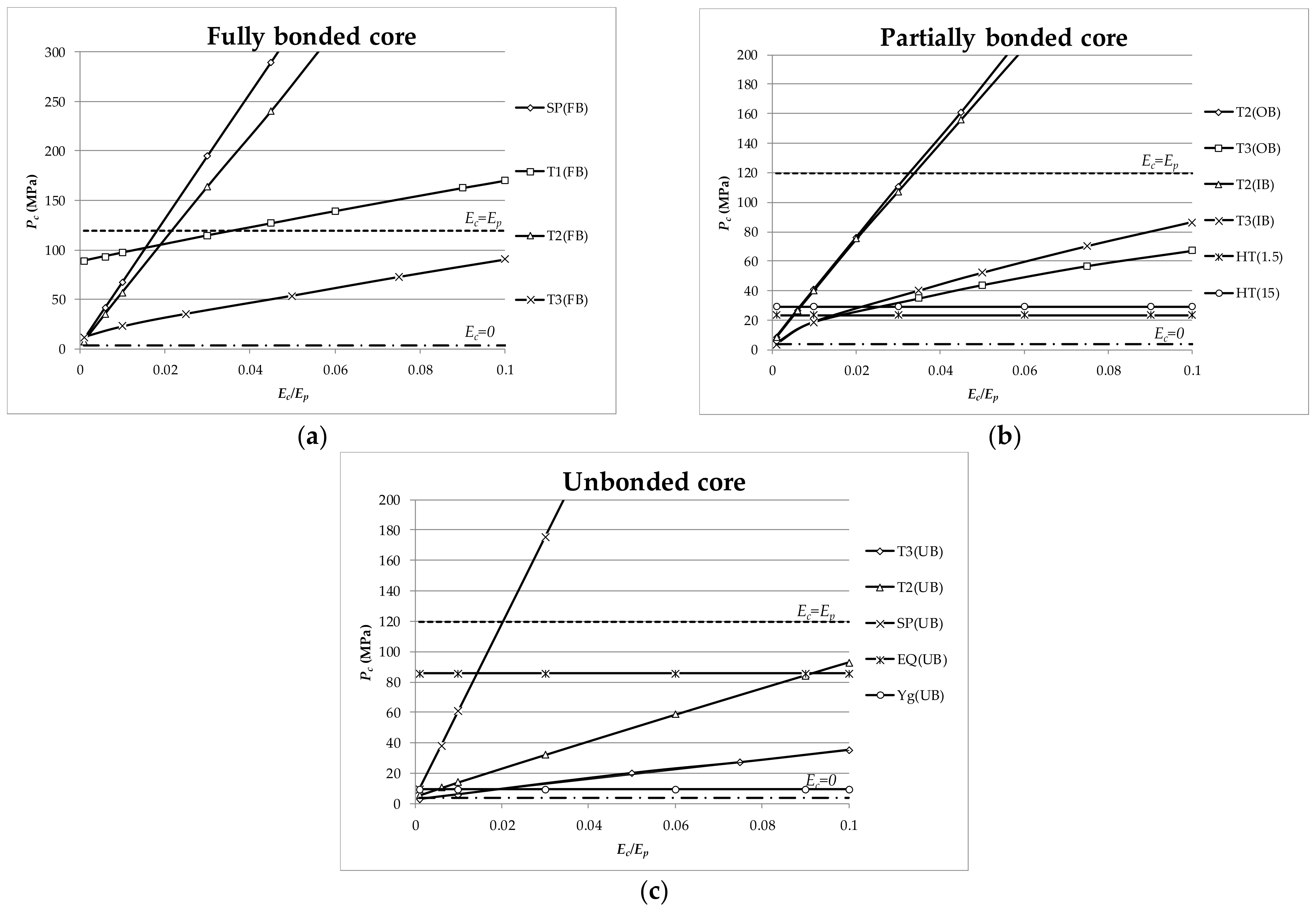
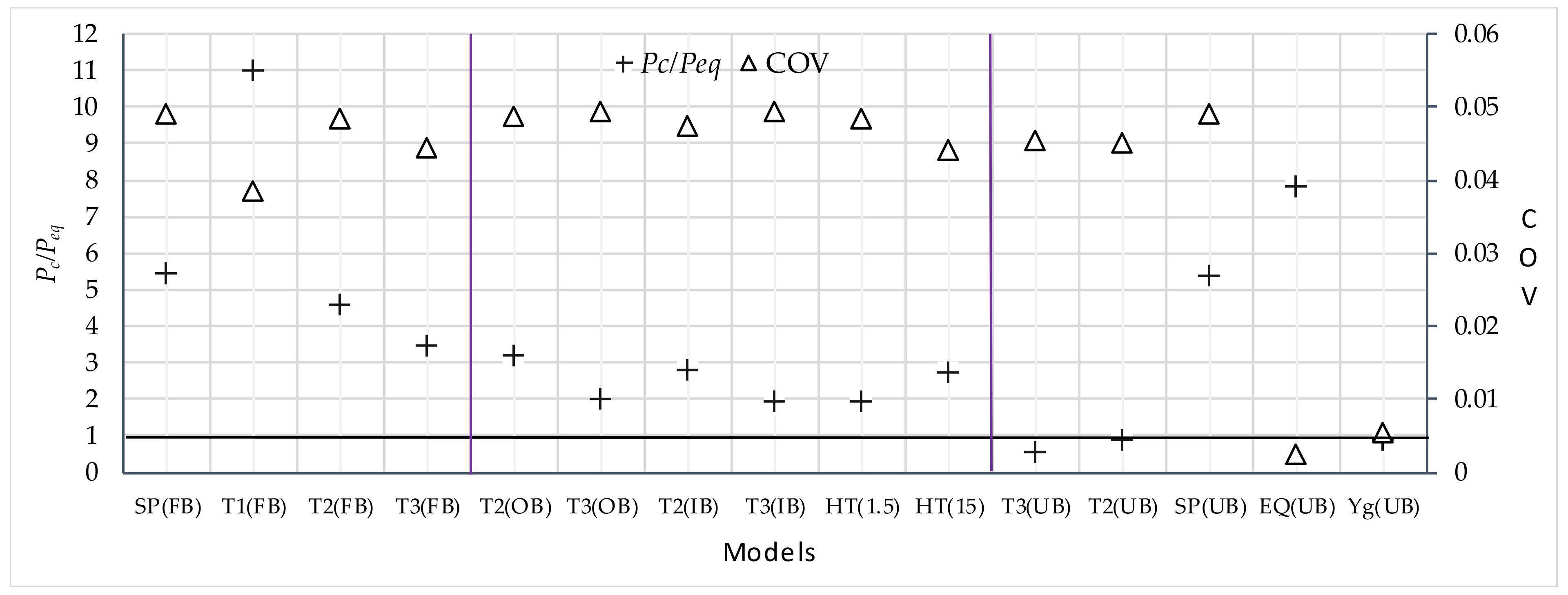
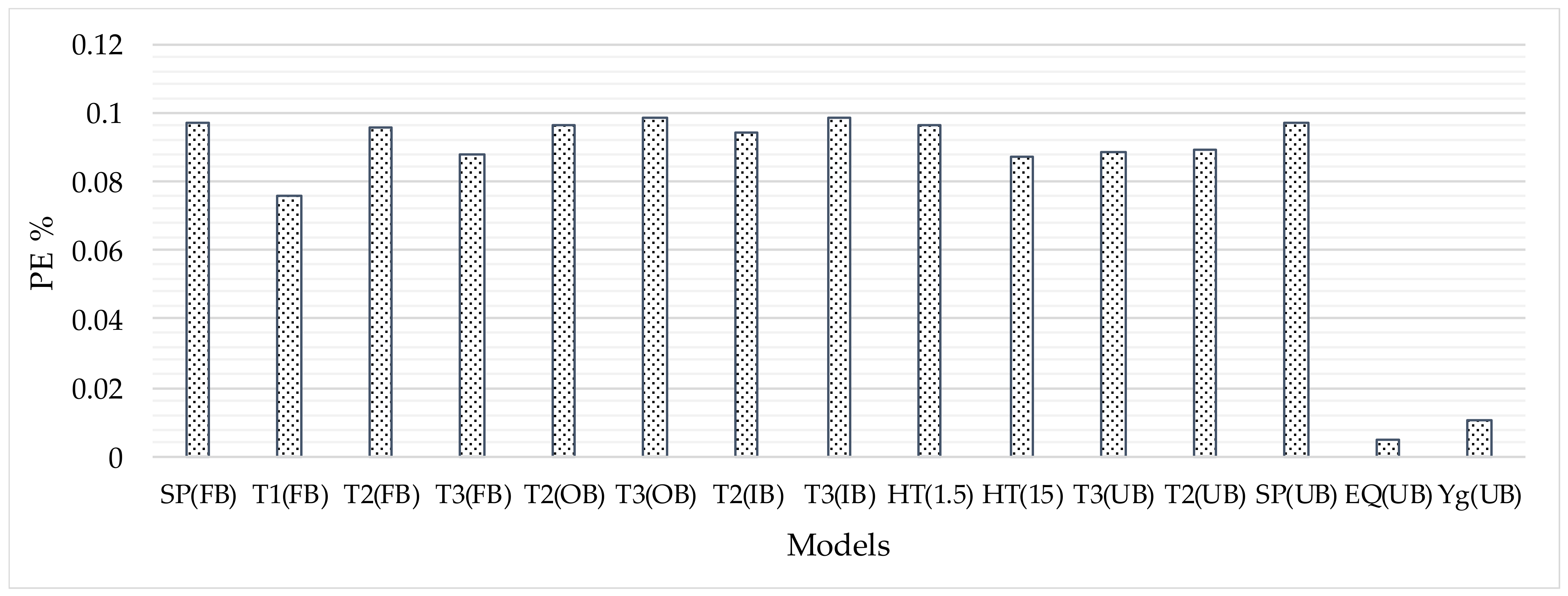
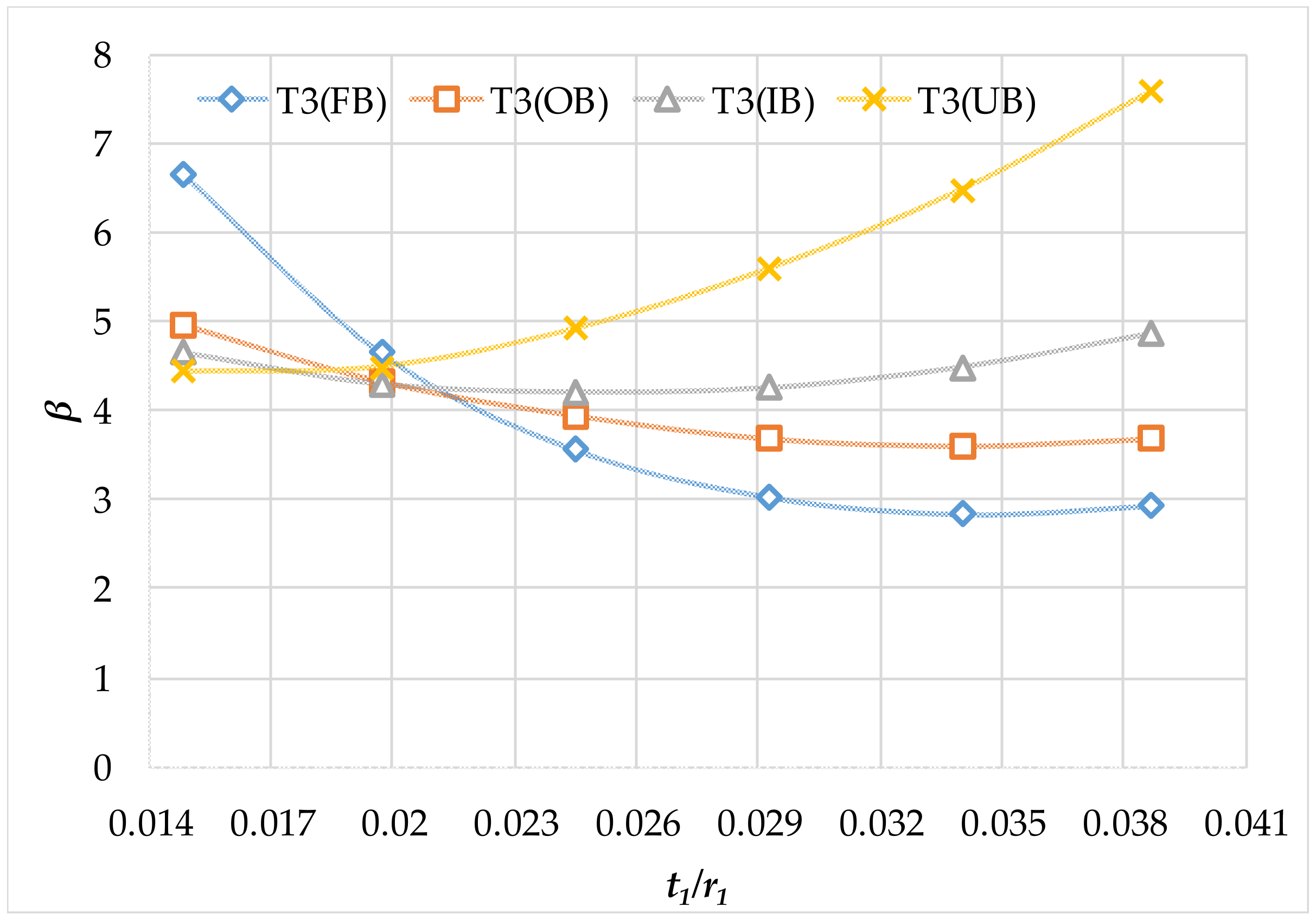
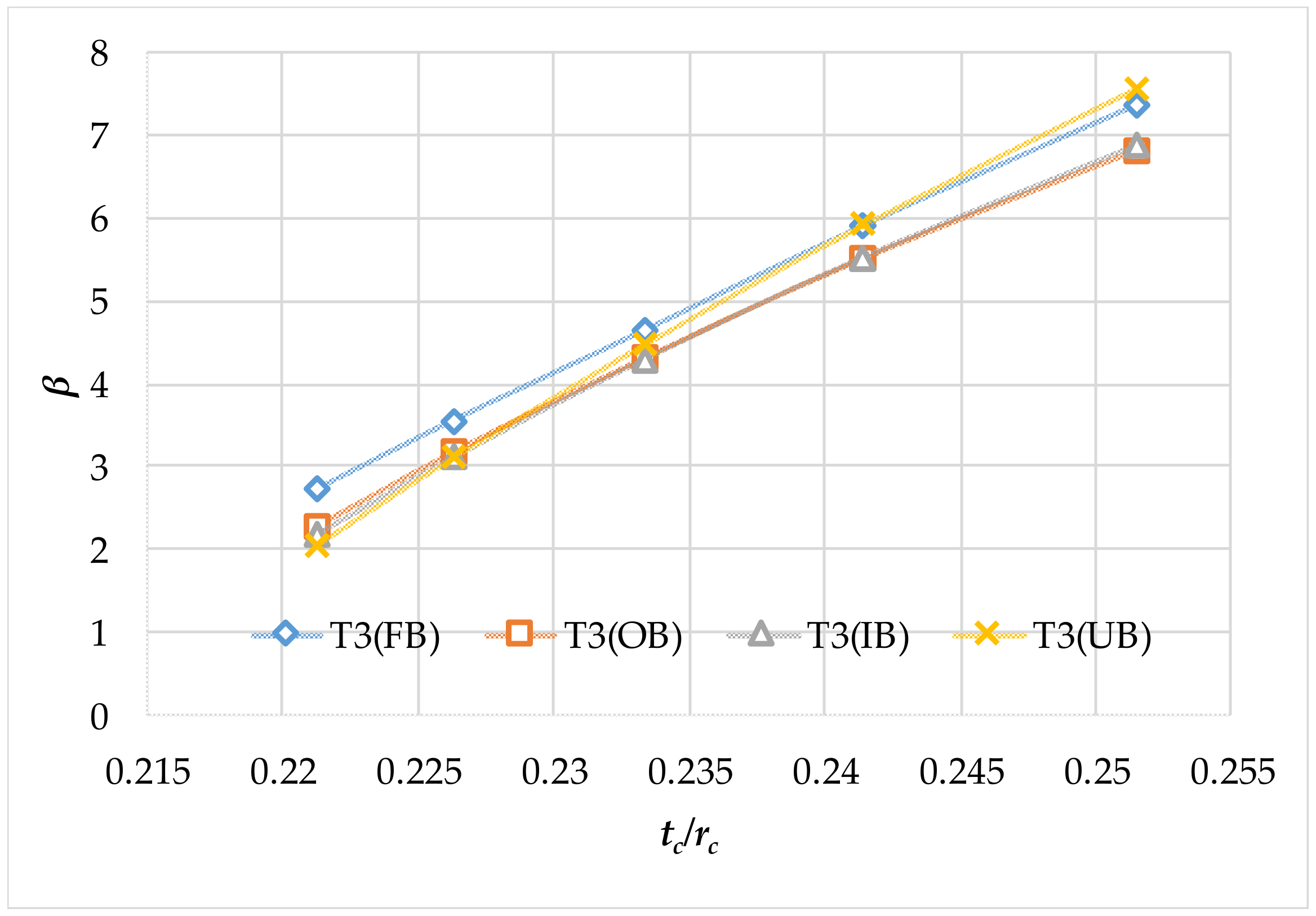
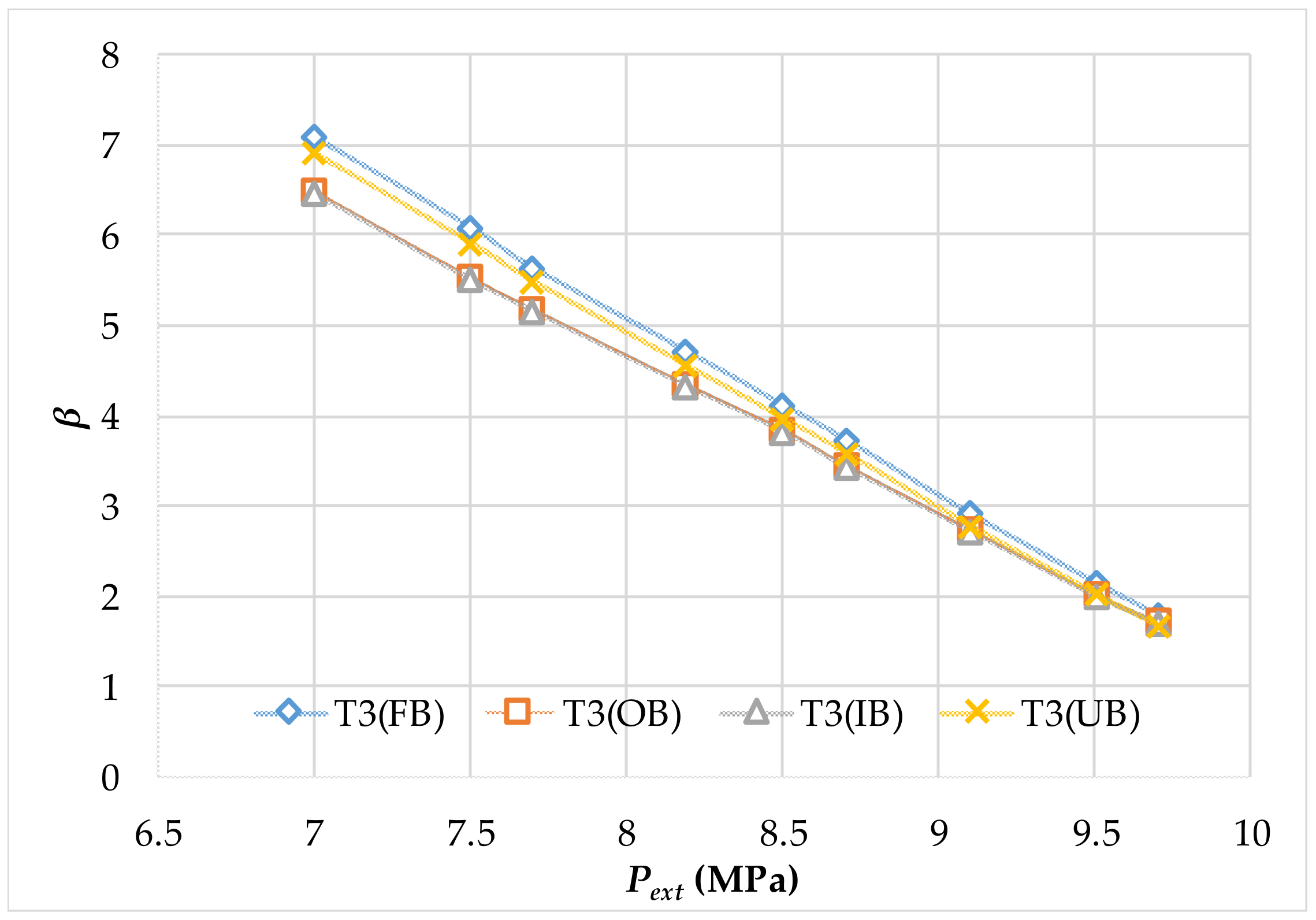
| σ1 = σ2 | vc | vp | Ec/Ep | t1/r1 | t2/r2 | r2/r1 | tc/rc |
|---|---|---|---|---|---|---|---|
| 205 MPa | 0.4 | 0.3 | 0.001–0.1 | 0.02–0.08 | 0.026–0.097 | 0.6–0.8 | 0.1–0.4 |
| σ1= σ2 (MPa) | vc | vp | Ec (GPa) | Ep (GPa) | D1 (mm) | t1 (mm) | D2 (mm) | t2 (mm) | ||
|---|---|---|---|---|---|---|---|---|---|---|
| Mean | 413 | {19.836} | 0.4 | 0.3 | 2 | 200 | 202.8 | 2 | 152.4 | 1.8 |
| COV | 8 | {0.0799} | 0.1 | 0.1 | 5 | 5 | 0.1 | 1 | 0.1 | 1 |
| Distribution | LN | N | N | N | N | N | N | N | N | |
| Reference | [15] | Assumed | Assumed | [34] | [34] | [15] | [15] | [15] | [15] | |
| Random Variable | Distribution | Mean | Standard Deviation | COV(%) | Characteristic Value(Xc), Pr (x < Xc) |
|---|---|---|---|---|---|
| Pext (MPa) | Gumbel | 8.19 {8.09} | 0.246 {0.192} | 3 | 8.649 (95% percentile) |
| Fully Bonded Core | Partially Bonded Core | Unbonded Core | |
|---|---|---|---|
| T3(FB) | T3(OB) | T3(IB) | T3(UB) |
| 4.65 | 4.31 | 4.28 | 4.50 |
| Variables | Fully Bonded Core | Partially Bonded Core | Unbonded Core | |
|---|---|---|---|---|
| T3(FB) | T3(OB) | T3(IB) | T3(UB) | |
| σ1 | 0.079 | 0.012 | 0.012 | 0.003 |
| σ2 | 0.066 | 0.011 | 0.012 | 0.266 |
| Ep | 0.414 | 0.505 | 0.560 | 0.318 |
| D1 | 0.092 | 0.151 | 0.105 | 0.097 |
| t1 | −0.076 | −0.187 | −0.125 | -0.105 |
| D2 | −0.079 | −0.117 | −0.082 | -0.079 |
| t2 | −0.055 | −0.034 | −0.101 | -0.078 |
| Pext | −0.891 | −0.819 | −0.780 | -0.892 |
| Fully Bonded Core | Partially Bonded Core | Unbonded Core | ||
|---|---|---|---|---|
| T3(FB) | T3(OB) | T3(IB) | T3(UB) | |
| Water depth (m) | 2912.3 | 1674.2 | 1601.7 | 489.6 |
| Variables | Fully Bonded Core | Partially Bonded Core | Unbonded Core | |
|---|---|---|---|---|
| T3(FB) | T3(OB) | T3(IB) | T3(UB) | |
| γR | 1.148 | 1.179 | 1.175 | 1.139 |
| γL | 1.109 | 1.11 | 1.11 | 1.119 |
| k | 1.273 | 1.308 | 1.304 | 1.275 |
Publisher’s Note: MDPI stays neutral with regard to jurisdictional claims in published maps and institutional affiliations. |
© 2022 by the authors. Licensee MDPI, Basel, Switzerland. This article is an open access article distributed under the terms and conditions of the Creative Commons Attribution (CC BY) license (https://creativecommons.org/licenses/by/4.0/).
Share and Cite
Bhardwaj, U.; Teixeira, A.P.; Guedes Soares, C. Probabilistic Collapse Design and Safety Assessment of Sandwich Pipelines. J. Mar. Sci. Eng. 2022, 10, 1435. https://doi.org/10.3390/jmse10101435
Bhardwaj U, Teixeira AP, Guedes Soares C. Probabilistic Collapse Design and Safety Assessment of Sandwich Pipelines. Journal of Marine Science and Engineering. 2022; 10(10):1435. https://doi.org/10.3390/jmse10101435
Chicago/Turabian StyleBhardwaj, Utkarsh, Angelo Palos Teixeira, and C. Guedes Soares. 2022. "Probabilistic Collapse Design and Safety Assessment of Sandwich Pipelines" Journal of Marine Science and Engineering 10, no. 10: 1435. https://doi.org/10.3390/jmse10101435






